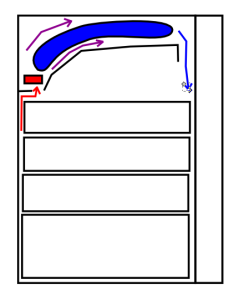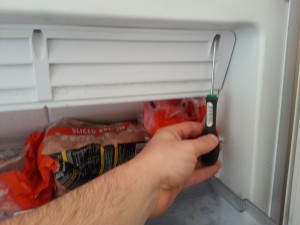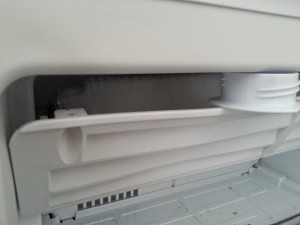The other day the wife kindly offered to get us an ice lolly while we were watching a film, unfortunately, the freezer door didn’t close properly due to a fault with the handle and it was left all night about 2cm open. When I got up the in the morning to make the coffee I found the freezer left open and the freezer trying to kill itself freezing the entire room. I quickly closed the door then re-opened it to find out how much food we’d lost.
My thought was that as the door had only been open a fraction there was a good chance most if not all the stuff in the freezer had remained frozen even if not at the -18 deg C necessary for a deep freeze. To my relief almost everything was still frozen, we decided to throw a couple of bits of meat that were up at the front of the draws which had an outside chance of having deforested but everything else was still good and frozen.
The problem though was even 24 hours after we had closed the door the freezer wasn’t getting down to temperature. When I found it the thermometer we keep in the freezer was reading about -4 deg C but after 24 hours the freezer had still only got down to -10 deg C but it had managed that 6 degree drop in the first few hours. Clearly was something wrong.
How a Freezer Works – Fixing a Freezer Left Open Over Night
After some research I now know a lot more about how freezers work and it turns out this is actually a fairly common problem but the solution is completely unexpected and doesn’t appear to be well known. The good news is that as long as your food hasn’t defrosted you can usually save the food and if you have a hair dryer you can save the freezer.
A modern freezer works something like this:
This is a cross-section through the freezer with the door represented by the rectangle at the front. The blue blob at the top is the cooling element, the red rectangle is a fan and the arrows show the flow of air. Obviously there is more to a freezer than this but these are the bits we’re interested in at the moment. Note that it may be possible to get a freezer that doesn’t have a fan but it will almost certainly still work in the way I’m about to describe.
In normal operation the fan draws “warm” moist air up the back of the freezer compartment and then blows it across the cooling element where it is guided down the front of the freezer compartment. This is a clever design because it means that the very cold air dropping down the front of the freezer compartment acts like an air shield when you open the freezer door and helps protect the food if the door isn’t properly sealed. When I say warm air is drawn up the back of the freezer compartment obviously warm is relative. I would expect the air to only be a degree or so warmer than the air coming out the front of the cooling circuit.
What’s interesting about this design is it also incorporates the frost-free (auto-defrost) mechanism but that turns out to be the freezers Achilles heel. As the warm air is blown on to the bottom part of the cooling element the water condenses out and freezes quite quickly – remember cold air can carry less water than warm. This means that ice builds up on the cooling element but it builds up at the back of the element. The freezer must have some way of raising the temperature in just this area to melt the ice and dispose of the water. A lot of freezers dump the water out the back on to the heat exchanger I believe ours dumps it out a drain at the bottom of the freezer compartment.
The problem if the door is left open is that very warm and moist air is able to rise up the inside of the door and when it comes into contact with the front of the cooling element a large amount of water will freeze on the element. Since this ice is well away from the area that the frost-free mechanism works on the freezer is unable to remove the ice. If the door is left open for any length of time it’s perfectly possible for the whole of the front of the element to freeze into a solid block of ice. The effect of this is that cold air can no longer circulate and the freezer will struggle to get down to it’s working temperature. The compressor on the freezer will run flat-out but all it’s able to is freeze the block of ice solid.
Fixing a Freezer Left Open Over Night
The solution is very simple. Switch the freezer off and leave it for 15 minutes to let any of the cooling fluid drain down to the bottom of the freezer. Open the door to the freezer and remove as best you can any covers of the front of the cooling element. I was unable to fully remove the cover on ours but I could open it enough for the next step. Get a hair dryer and play hot air over the front of the cooling element to quickly melt the ice that has formed there. Let the cooling element cool to about room temperature and then close the door and switch the freezer back on. If all has gone to plan your freezer will now be able to effectively circulate cool air through the freezer and it will be down to temperature in a few hours.
Sorry these photos are so out of focus, it was early in the morning and I was working one-handed.
This photo shows me removing screws that secure the front cover. I needed to use a torx driver and discovered a gorilla had put the screws in. You can just make out some of the ice creeping out from the cold air vents.
Unable to get the cover complete off I propped it open with part of a baby bottle (I think). You can clearly see the block of ice that had formed and the cooling elements embedded in it. At this point I had already given it a blast with the hair dryer. When I first opened it the cooling elements were nowhere to be seen!



